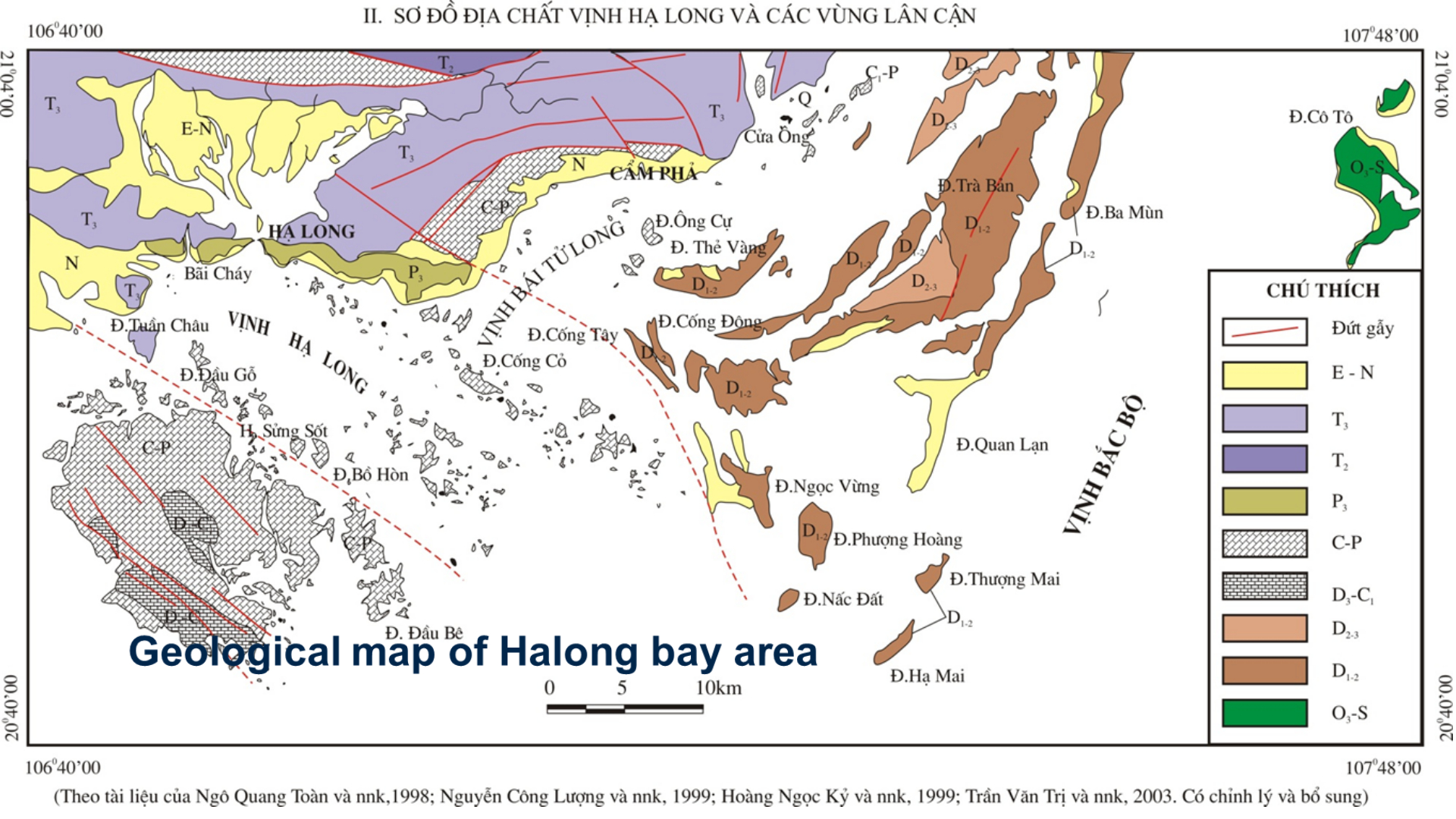Bac Son Fm
Type Locality and Naming
Widespread in Viet Nam and Southeast Asia. Named after Bac Son – Kim Hi massif (East Bac Bo Basin). Nguyen Van Liem, 1978.
Synonym: Da Mai Fm (preferred name by Tong-Dzuy Thanh and Vu Khuc (2011, Editors; Stratigraphic Units of Viet Nam): "The described Carboniferous-Perniian light grey limestones were described by geologists under different names, such as: Bac Son Group, Muong Long Formation, Middle-Upper Carboniferous - Permian, Anthracolitic, Uralo-Permian, Fusulines Limestone, Producius Limestone, Middle Limestone, etc.. The most widespread name is Bac Son Formation first used by Nguyen Cong Luong (1980); it has been used largely in geological mapping at different scales, especially at 1:200.000 scale. … The term Bac Son was used a long time ago by Mansuy H. and Colani M. (1925) for a Quaternary (Holoccne) stratigraphic unit and has been becoming well known in regional stratigraphy and world archaeology (Saurin E. 1956. … Furthermore, the carbonate stratigraphic body named as “Bac Son Formation” (Nguyen Van Liem 1978) was later described than the Da Mai Fm (Dussault L. 1929; Nguyen Xuan Bao 1970). Therefore the name Da Mai can be considered a valid name, and the name Bac Son is its synonym." [However, this Lexicon retains the "Bac Son Fm" as used by Tran Van Tri and Vu Khuc (2011, Editors; Geology and Earth Resources of Viet Nam), which as indicated, is the most widespread name.]
[Figure: Bắc Sơn Fm: Type section - Limestone of Bắc Sơn Fm in the Hạ Long bay (images courtesy of Prof. Ta Hoa Phuong, Vietnam Natl. Univ. Hanoi)]
[Figure: Geological map of Halong bay area (images courtesy of Prof. Ta Hoa Phuong, Vietnam Natl. Univ. Hanoi)]
Lithology and Thickness
In general, it consists of light grey and grey, mainly thick-bedded to massive dolomitised limestone, argillaceous limestone, and organic limestone. The thickness of this stratigraphic body varies from 1000 to 1500 m. In Long Son an Ha Giang provinces, the formation is about 700-1000 m thick, usually composed of two parts: (1) White-gray, thick-bedded in lower part, but massive in upper part, dolomitic limestone about 300 m thick; (2) Gray, sometimes pinkish in the upper part, coarse-grained, thick-bedded limestone about 400 m thick, containing Early to Middle Permian forams, such as Pseudodoliolina ozawai, Triticites paramontiparus, Occidentoschwagerina sp., Cancellina sp. In some places, the formation begins with organic limestone, composed mainly of crinoid ossicles.
In West Bac Bo, the formation is 800-1000 m thick, including light grey, thick-bedded limestone, sometimes there are cherty limestone beds or chert nests. Among fossils, apart from forams, there are corals giving the age of Visean to Middle Permian. Forams from the upper part of the formation include Zellia muongthensis, Neoschwagerina craticulifera, Verbeekina aff. verbecki, Neofusulinella sp., Pisolina sp., Pseudofusulina sp., Parafusulina sp., etec.
[Figure: Bắc Sơn Fm: Type section - Limestone of Bắc Sơn Fm in Đồng Văn Highland (images courtesy of Prof. Ta Hoa Phuong, Vietnam Natl. Univ. Hanoi)]
[Figure: Bắc Sơn Fm: Type section - Limestone of Bắc Sơn Fm in Phong Nha – Kẻ Bàng World heritage (images courtesy of Prof. Ta Hoa Phuong, Vietnam Natl. Univ. Hanoi)]
[Figure: Bắc Sơn Fm: Landscape image (images courtesy of Prof. Ta Hoa Phuong, Vietnam Natl. Univ. Hanoi)]
Relationships and Distribution
Lower contact
Diachronous. Rests unconformably on units such as Lung Nam Fm (Viet Bac region), Da Nieng Fm (West Back Bo), Con Voi Fm (East Back Bo), Pho Han Fm (Viet Bac and East Bac Bo), Cam Thuy Fm, Tue Le Fm and Suoi Be Fm (West Back Bo), Tay Trang Fm (Viet-Laos NW), La Khe Fm (North Trung Bo).
Upper contact
Diachronous. Consists of an erosional surface, therefore its age is various in different places, but mainly of Middle Permian. Overlain by different units, including Dong Dang Fm (Bac Bo), Cam Lo Fm (North Trung Bo).
Regional extent
Carboniferous-Permian limestone occurs broadly in the Bac Bo and North Trung Bo regions, in such provinces as Hai Phong, Quang Ninh, Lang Son, Cao Bang, Bac Kan, Thai Nguyen, Son La, Lai Chau, Hoa Biiih, Thanh Hoa, Nghe An, Ha Tinh and Quang Binh. In many places, they form great limestone massifs, such as the Bac Son - Kim Hi, Dong Mu, Ke Bang limestone massifs and the Dong Van limestone plateau.
GeoJSON
Fossils
See lithologic descriptions. Benthic forams, corals, crinoids.
Age
Depositional setting
Carbonate platform
Additional Information




